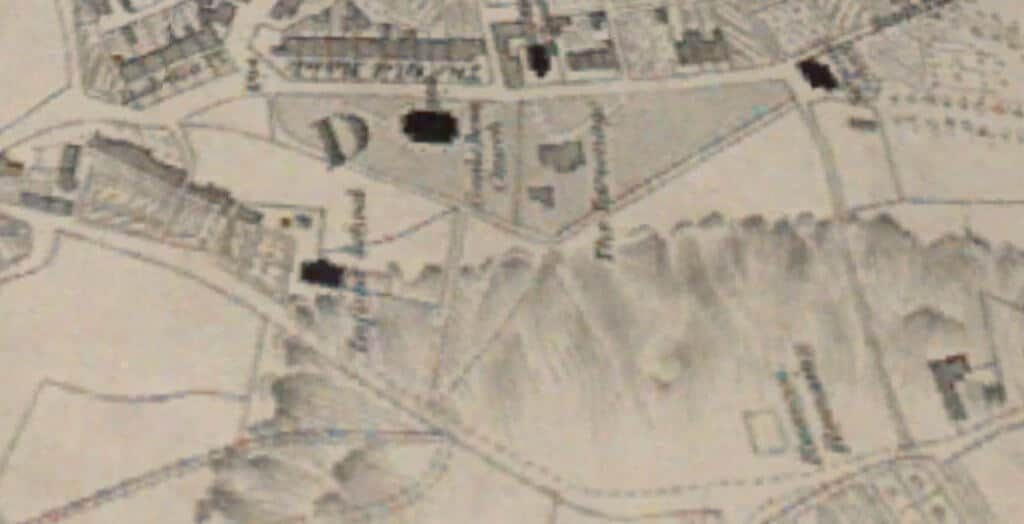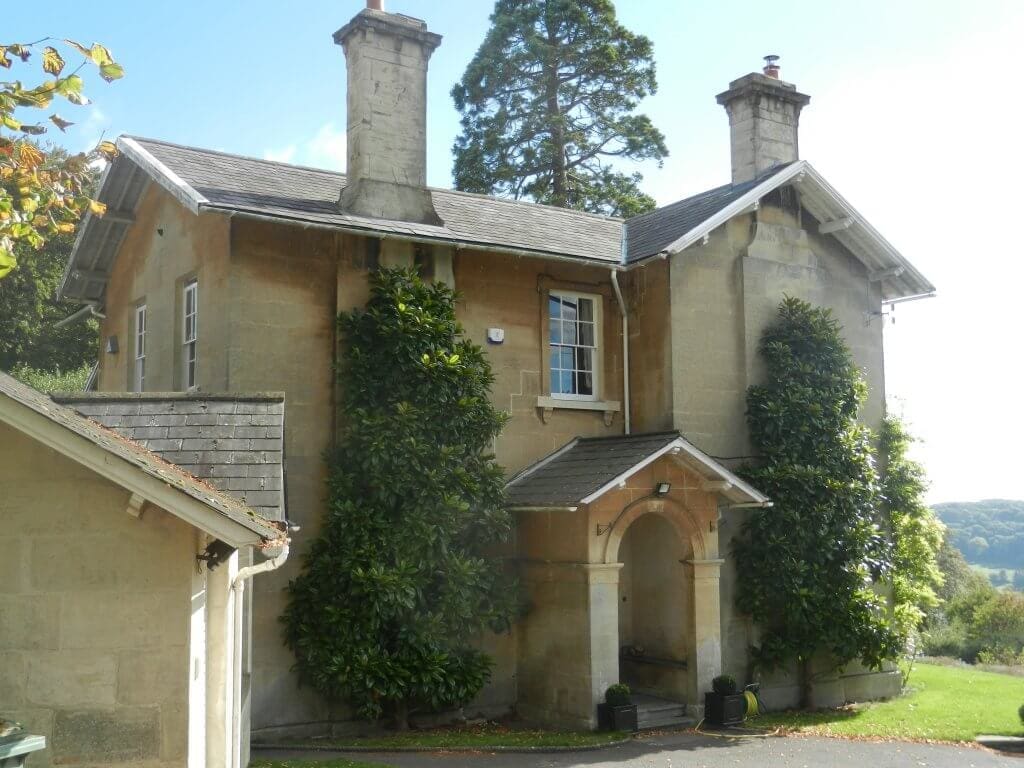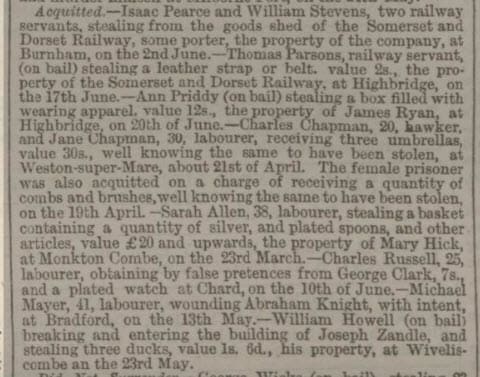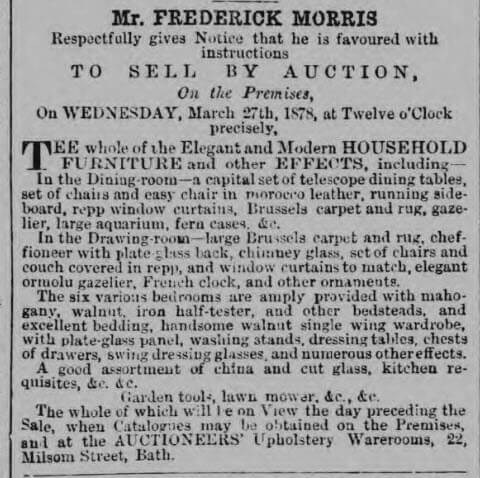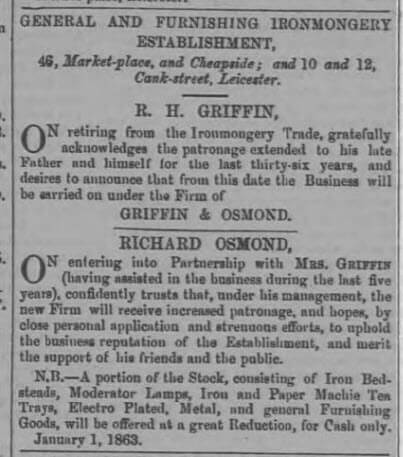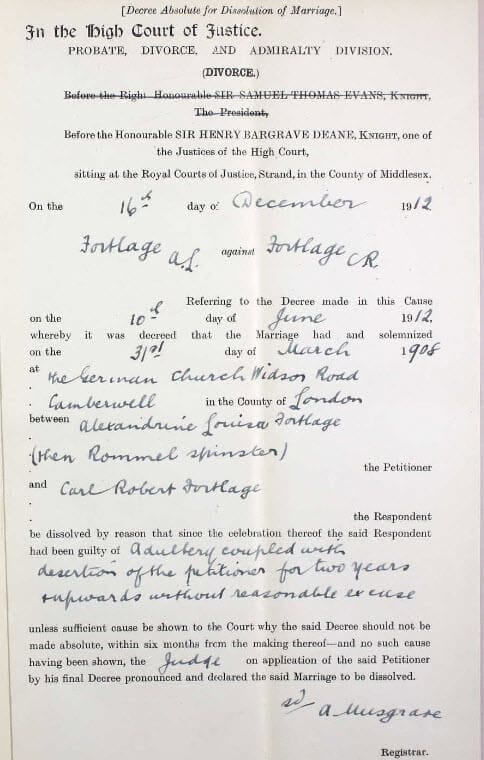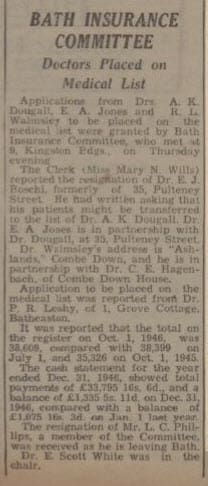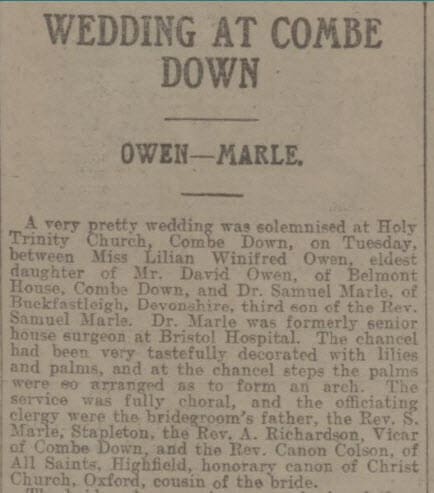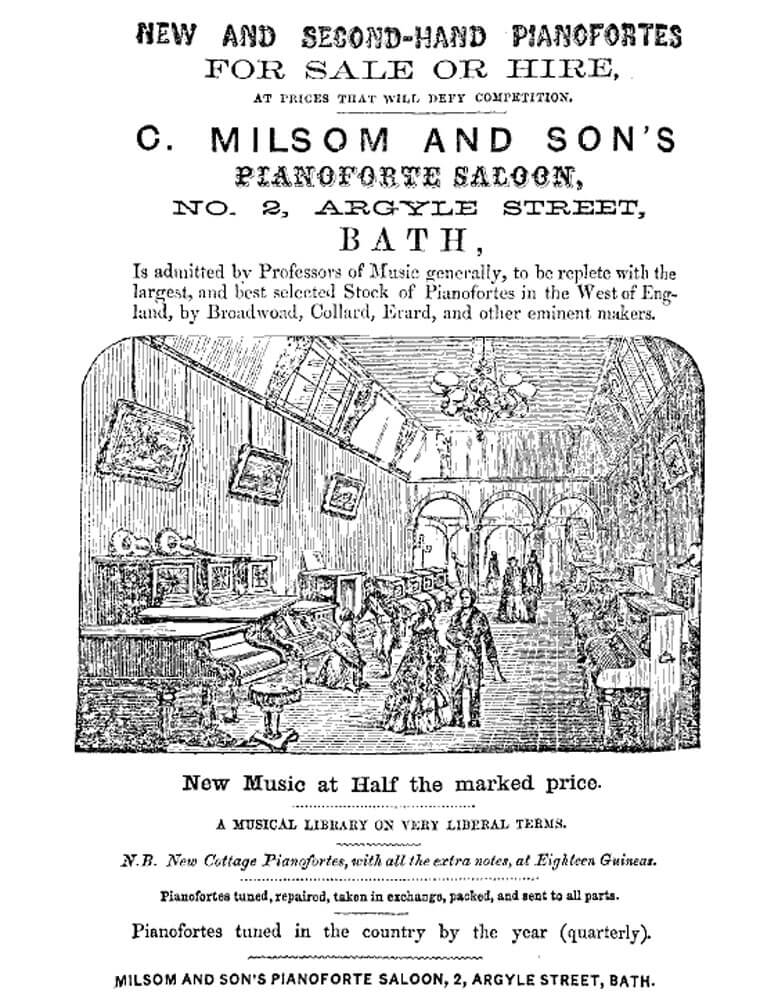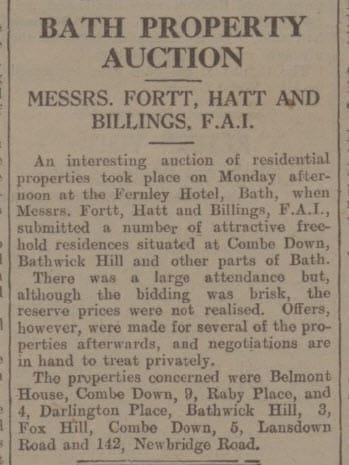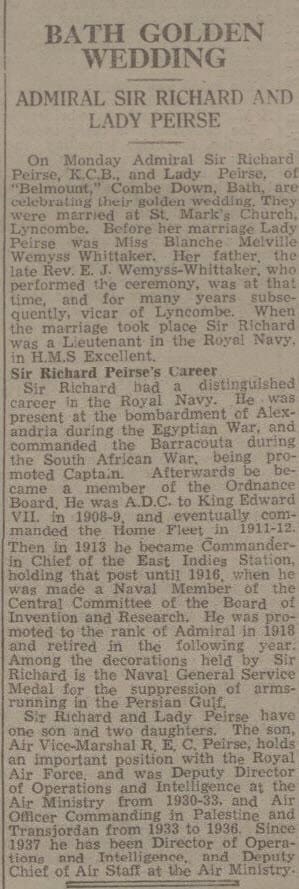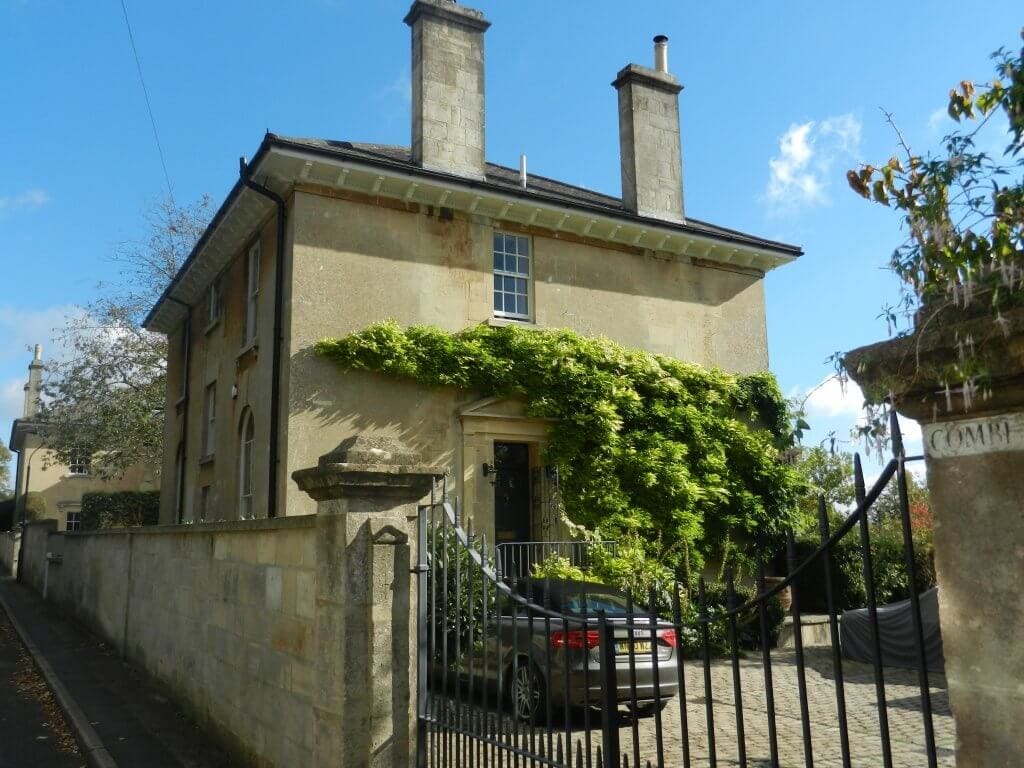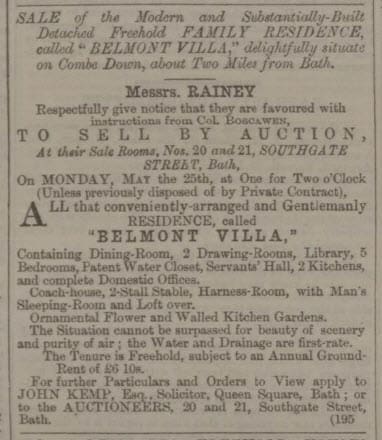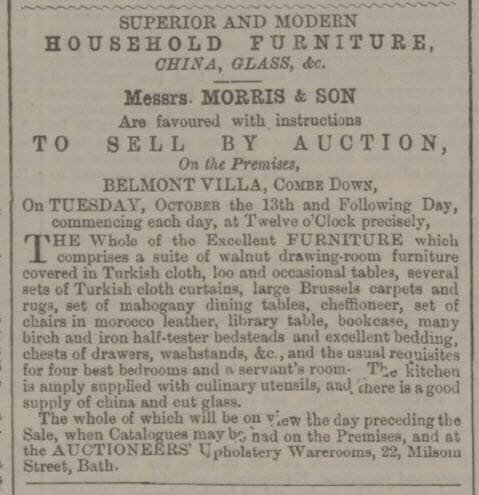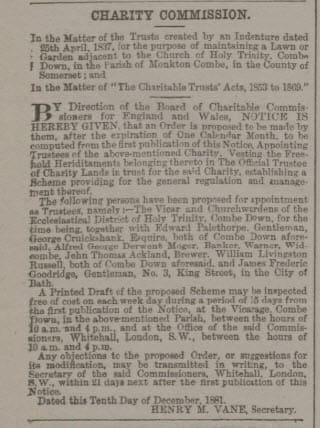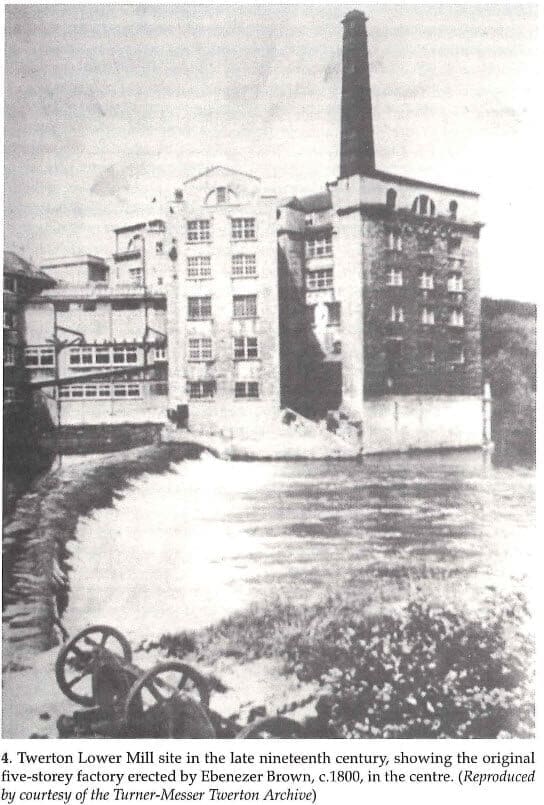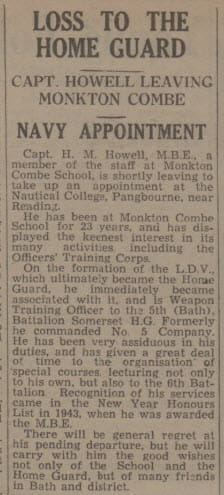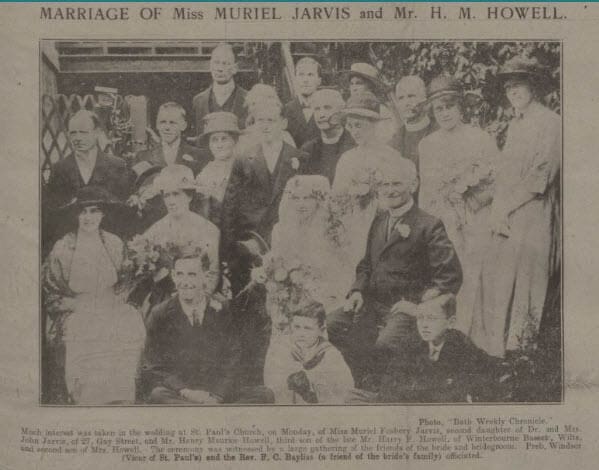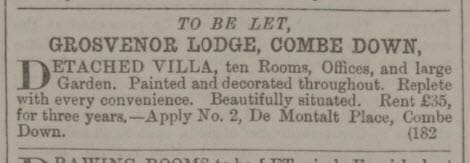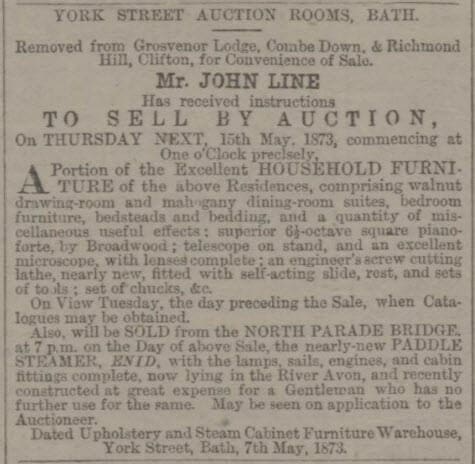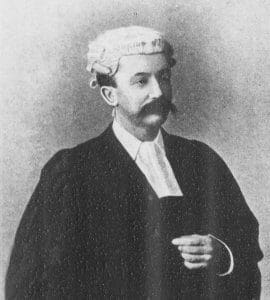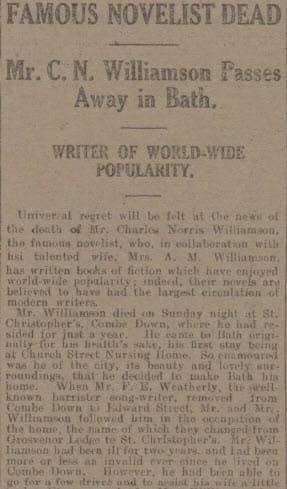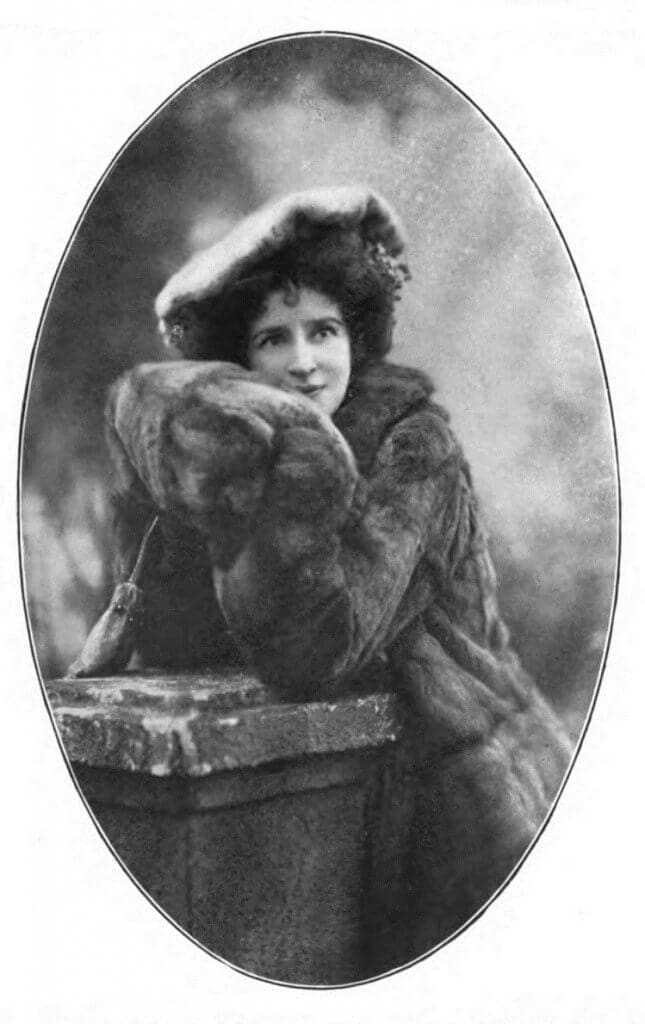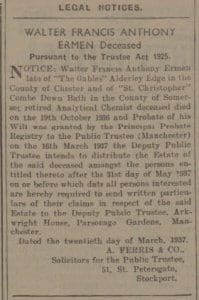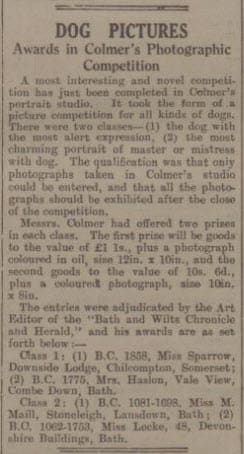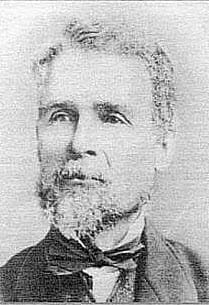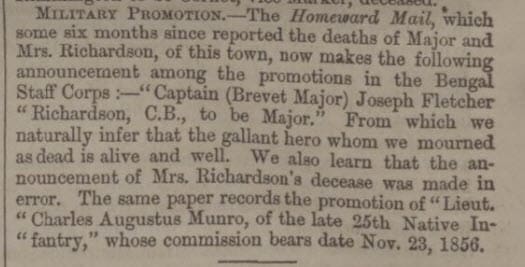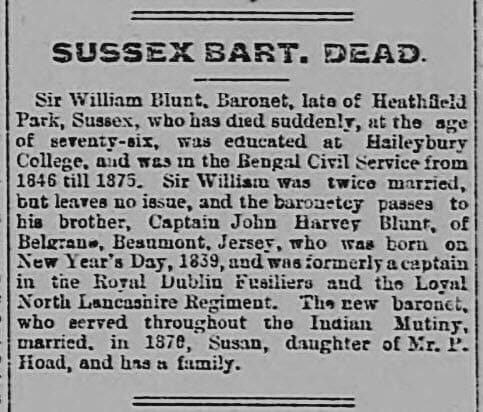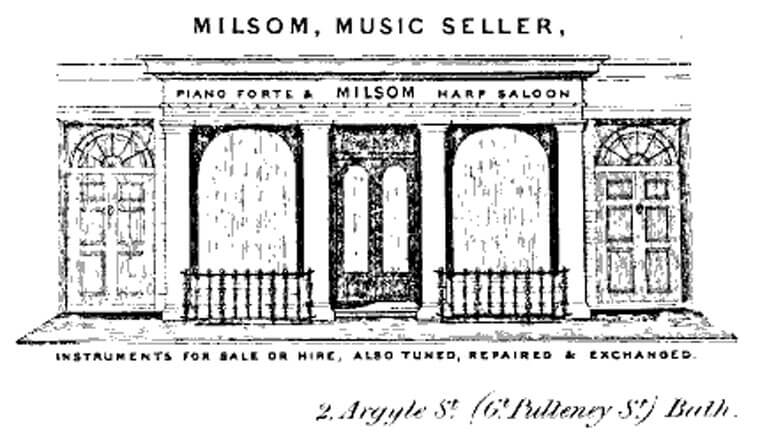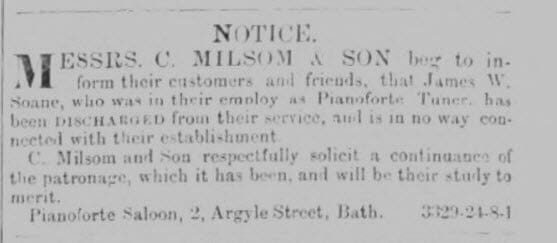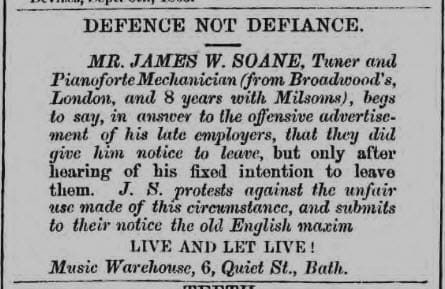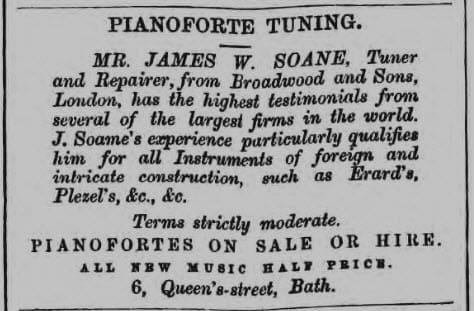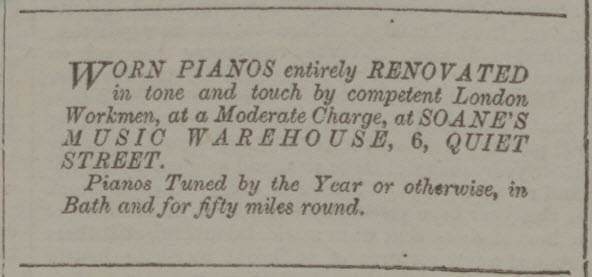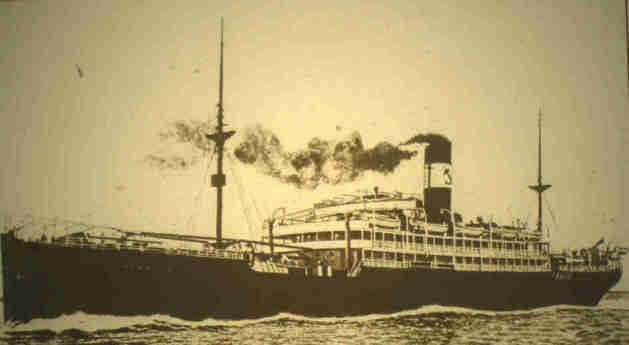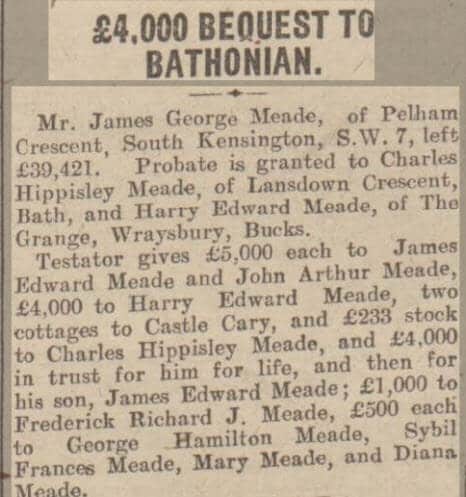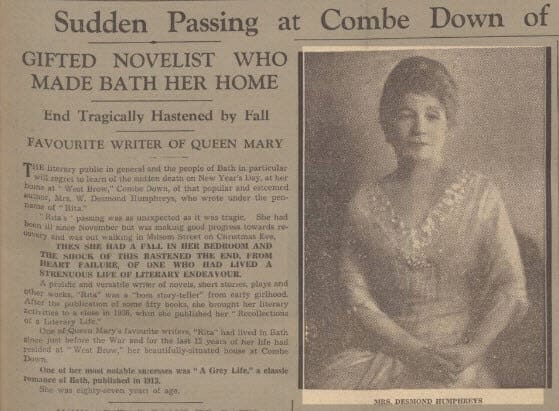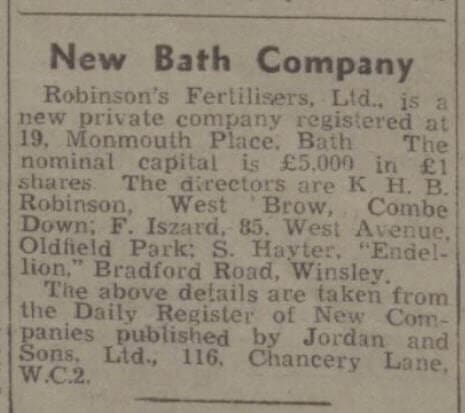Belmont
It is clear from Cotterel’s map of 1852 that no housing existed on Belmont at the time, though the line of what would become the road is clear.
It is also clear that all the stunning and appealing Belmont villas were built by 1904.
Ashlands
In an article about Freshford & Limpley Stoke Cottagers’ Friend Society in the Bath Chronicle and Weekly Gazette for Thursday 8 August 1861 the Miss Galendos (sic) are noted as visitors and living at Claremont Villa, Combe Down.
These are the daughters of Charles and Ann Galindo who, by 1864, were living at Welford House.
The 1871 census has Charity Jane Higgs (née Hick) (1830 – 1878) living at the house. Her husband George Higgs (1826 – 1864) had been a merchant.
In 1869 a woman named Sarah Allen had been charged with stealing some silver plate worth £20 from her. At Somerset Quarter Sessions some time later she was acquitted.
After Charity died her effects were auctioned.
By 1881, the house was occupied by William Franklin (1852 – 1921) and his wife Emily Ridge (1836 – 1923). At the time he was a teacher with Monkton Combe School, not yet having started Combe Down School. Six pupils were boarding with them.
No occupant is given in the 1891 census.
By 1901 Charles Richard Osmond (1868 – 1933), his wife Edith Emma Squire (1863 – 1952) and their family occupied the house.
He is living on his own means but he had assisted his father who was an ironmonger. His father Richard Osmond (1837 – 1905) was the Leicester agent for Mappin & Webb[1] so he seems to have become more than an ordinary ironmonger!
In 1911 the census gives Maurice Hermann Fortlage (Son of the head). Maurice Hermann Fortlage (1901 – 2001) was the son of Carl Robert Fortlage (1881 – 1941) and Alexandrine Louise Rommel (1881 – 1955).
On the day of the census his mother was staying at the Headland Hotel, Coverack, Cornwall with her sister Fredrica Ada Rommel (1885 – 1973).
She and her husband had married in 1908 but it appears that he had committed adultery and deserted her. They divorced in 1912.

It appears that Alexandrine Louise Rommel was an accomplished violinist. She remained in Bath until her death.
Ashlands was next occupied by Capt George Rivington RN (1833 1915) and his wife Jane Eleanor Sangster (1844 – 1937) who had previously resided at Combe Villa (Scott House).
Capt. Rivington died soon after the move but his widow lived there until the 1920s.
By 1925 the house was occupied by Lt Col Arthur John Pilcher (1866 – 1960) and his wife Edith Blair (1869 – 1942).
Their families were both military and served in India. His father was Col Jesse Griggs Pilcher (1839 – 1917) and his mother Mary Jones (d. 1894). Her father was Gen Charles Renny Blair (1837 – 1912) and her mother Juliana Williams (1843 – 1916).
His brother was Gen Edgar Montagu Pilcher DSO CB CBE (1865 – 1947) who married twice, firstly Lilias Mary Campbell (1865 – 1940) and secondly Brenda Georgiana Warr (1886 – 1972).
Lilias Mary Campbell, Gen Pilcher‘s first wife, was the grand daughter of Sarah Stringer Falkner (1820 – 1910) who was the daughter of Francis Henry Falkner (1786-1866), an Alderman of Bath, executor of George Stothert (1755-1818) and brother to Richard Falkner (1796 – 1863), a banker, a partner in Tufnell, Collett, Falkner & Co. and a mortgagee before 1850 of 115 and 117 Church Road.
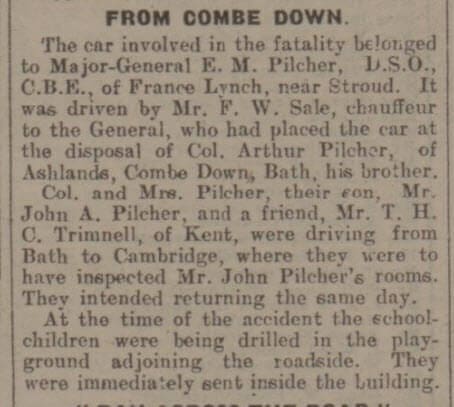
Gen Pilcher was heavily involved in local affairs being on the Monkton Combe Parish Council for many years.
He was present at a very unfortunate fatal accident when a young girl ran into the road outside here school in 1931.
Gen and Mrs Pilcher’s nephew was Sir John Arthur Pilcher (1912 – 1990) who had some controversial views about Japan: “British envoy painted Japanese as narrow-minded egoists” in the Japan Times of 1 January 2003.
By 1946 Edgar Norman Fenwick (1892 – 1971) and his wife Beatrice Mary Martin (1895 – 1968) occupied the house. The engagement of their daughter Sheilah Mary Fenwick (1925 – 1995) to Paul Godfrey Jenkins (1922 – 2008) was announced in the Chronicle.
By 1947 Dr Robert Lane Walmsley (1909 – 1982) and his wife Marjorie Eileen Broadbent (1906 – 1992) lived at Ashlands.
The clipping from the Chronicle shows Dr Walmsley’s request to be placed on the medical list by the local insurance committee.
Before the establishment of the National Health Service in 1948 David Lloyd George‘s National Health Insurance Act 1911 provided for the compulsory insurance of lower paid workers and set a fixed capitation fee for doctors.
The government paid two ninths of these fees; the remainder was made up by national insurance.
National Health Insurance Committees, which represented doctors, local authorities and approved societies, administered the system.
However, the act only applied to wage earners, their families had to rely on the outpatient clinics of voluntary hospitals for treatment and many were not covered at all.
The Dr Hagenbach mentioned as Dr Walmsley’s partner is Dr Charles Edward Stonebridge Hagenbach (1901 – 1993).
As can be seen from the other clipping he was the subject of an extraordinary libel attack in 1941. The patient was later sent to a mental home.[2]
Belmont House
From the Scottish census we know that George Cruickshank (1814 – 1896) and his wife Louisa Thomas (1823 – 1860), together with their children Hannah (1846 – 1909), George (1848 – 1892) and Mary (1851 – 1909), were living at 37 Lauriston Place, Edinburgh and he describes himself as a hosier.
There were a number of Cruickshanks operating as hosiers in Edinburgh but the Scottish Post Office directory for 1841 – 42 gives a George Hosier operating from 59 George Street in Edinburgh and it seems possible this is he.
We know that Belmont House was built around 1854 as per Peter Addison[3]:
Three more coffins were found in 1854 whilst Belmont House was being built for George Cruikshank, a local landowner. They lay with the heads to the north, indicating a heathen burial.......Actual evidence of building was discovered in 1860 just below Belmont House. The excavated area contained about six rooms, some quite large, 30' x 18', with a hypocaust, arranged around a courtyard. An important discovery was made in the shape of colourless glass vessels, very little of which had, at that time, been found in the Bath area. Also found were earthenware fragments, ox horns, coins, bronze, iron ornaments and numerous other pieces. In all 326 Roman coins were found at this time, which George Cruikshank presented to Taunton museum.
George Cruickshank lived at Belmont House until his death in 1896.
After his first wife died he married twice more. In 1861 to Elizabeth Sarah Prowse (1816 – 1878) and in 1879 to Charlotte Baker (1816 – 1907).
Charlotte continued living at Belmont House until her death in 1907.
By 1911 Charles Edward Theodosius (1864 – 1950) and his wife Lillie Ascherson (1868 – 1957) as well as their daughter Helen (b. 1900) were living at Belmont House. He was a tax inspector.
By 1912 Belmont House was occupied by David Owen (1850 – 1933), his wife Lilian Peake (1861 – 1925) and their family. His daughter Lilian Winifred Owen (1884 – 1956) married at Holy Trinity Church that year.
David Owen founded the chartered accountancy firm David Owen & Co. in 1871 and had offices in Bath, Warminster, Marlborough and London.
The firm still exists with offices in Marlborough and Devizes.
The Bath element of the practice became R D Owen & Co. and it too still exists.
He was well known and a director of many local companies such as Duck Son & Pinker, which opened in 1848 and closed in 2011 after 163 years of trading.
Also C Milsom & Son established in 1825 which was taken over by Duck Son & Pinker in 1921. He was also a director of Wessex Associated News, publishers of the Bath Chronicle.
By 1919 Harry William Fox Garland (1883 – 1971) and his children occupied Belmont House.
His wife had been Helen Georgina Whitefoord (1879 – 1911).
His great great grand father John Garland (1722 – 1810) was a clothier and cloth dresser of Simpson Fold, Leeds and had bought the now demolished 170 acre Netherwood Hall estate near Darfield, Barnsley in 1777 and become a gentleman farmer.
Netherwood was a Georgian building but probably included remnants of the former manor house. After his father died, in 1890, the hall was sold to the Mitchell Main Colliery Company.
Belmont House was put up for sale in 1937 but failed to meet its reserve. However, by 1939 Adm Sir Richard Henry Peirse KCB KBE MVO DL JP (1860 – 1940) and his wife Blanche Melville Wemyss-Whittaker (1864 – 1951) lived there.
His son was Air Chief Marshal Sir Richard Edmund Charles Peirse KCB, DSO, AFC (1892 – 1970) who was educated at Monkton Combe School. His grand son was Air Vice Marshal Sir Richard Charles Fairfax Peirse, KCVO, CB (1931 – 2014).
Combe Ridge

The first mention of Belmont Villa (now Combe Ridge) and Belmont House is in 1855.
In 1861 Belmont Villa was occupied by Col Hugh Augustus Boscawen (1805 – 1881) and his wife Ellen Maria Fergusson (1826 – 1882) who had served in India. They remained until about 1863.
Col Boscawen was the grand son of Hugh Augustus Boscawen MP (1750 – 1795) and his wife Anne Winter (1754 – 1827).
His grandfather was the illegitimate son of Gen Hugh Boscawen PC 2nd Viscount Falmouth (1707 – 1782) and himself the grandson of Arabella Churchill (1648 – 1730) and Col Charles Godfrey (1648 – 1714).
Arabella was the mistress of King James II, and the mother of four of his children. She was also sister to Gen John Churchill, 1st Duke of Marlborough, Prince of Mindelheim, KG, PC.
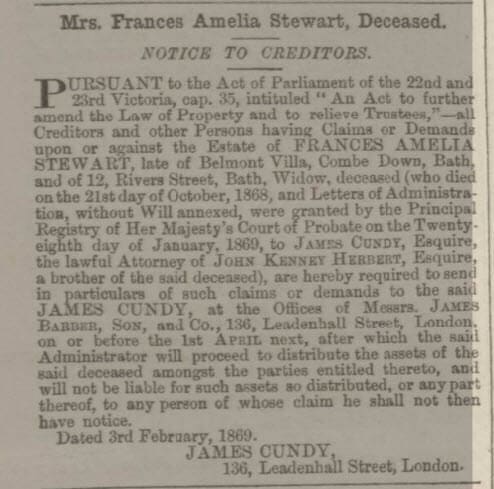
Frances Amelia Stewart (née Herbert) (1823 – 1868) occupied the house from about 1863 – 1868, but I have been unable to establish any more about her.
By 1871 William Winchester (b. 1810) and his wife Susannah (b. 1816) and three of their daughters were living at Belmont Villa. Other than that he was a retired tailor I have been unable to establish any more about him or his family.
By 1881 William Livingstone Russell (1828 – 1911) was living at Belmont Villa with 3 of his sisters: Christine G Russell (1827 – 1910), Jane Gray Russell (1832 – 1902), Sophia Maria Jamieson Gray Russell (1835 – 1912).
William Livingstone Russell was a Scot who described himself in 1881 as a travelling draper and seems to have done rather well. When he died he left £41,548 16s 0d or about £14,760,000.00 today[4].
He also appears living at Belmont Villa in 1911 with his sister Sophia Maria Jamieson Gray Russell and his sister Jane Gray Russell stated she was living at Belmont Villa in her will.
In 1881 he became a trustee of the Holy Trinity lawn and garden. He left a charitable gift for the poor of the parish in his will.
By 1891 Belmont Villa was occupied by Sarah Gregory Biden (née Symonds) (1815 – 1898) the widow of James Biden (1803 – 1872) who was a brewer, maltster and spirit merchant. She was living there with her son George Graham Biden (1850 – 1937).
Her husband had also been an author of religious works including:
- Truths Maintained. (No. II.) The Church On Earth, Not A Body Having An Ecclesiastical Organisation, But Composed Of Members Of Christ’s Body In Spiritual Union. By James Biden, Monckton House, Anglesey, Hants, Author Of “The True Church.”
- The Church Her Destinies. By James Biden.
- The T rue Church Showing What Is The True Church. The Ingathering Of The Jews To The Church ; In What Manner And When ; The Course Of The Church, The Past, The Present, And The Future. By James Biden
- The Bible Plan Unfolded. James Biden.
In 1901 the house was occupied by Mary Anne Phebey (née Borer) (1841 – 1911) who had been married to James Phebey (1845 – 1884) who had been a shipwright. I have been able to find out no more about her.
By 1920 and now called Combe Ridge, the house was occupied by Walter John Cook (1857 – 1925) and his wife Kate Elizabeth Hibbard (1864 – 1938).
Walter John Cook was senior director of W & R Cook, wholesale clothiers in Twerton at Twerton Lower Mill.
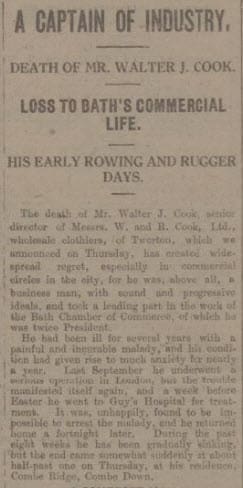
An Institution of Mechanical Engineers visit to W. and R. Cook of Lower Mills, Twerton-on-Avon, Somerset in 1935 said:
The clothing factory derives power from a generator driven by a water turbine, arranged to run automatically in conjunction with the city electricity supply, through a switchboard of up-to-date pattern. Over forty cutters are employed on bespoke tailoring in the cutting room. An electrically driven band knife will cut from thirty to forty layers of cloth at a time. An up-to-date system of Hoffman presses has been installed. In separate sections of the factory, coats, vests, and trousers are made complete. Machines for buttonhole making, for sewing on buttons, for edge basting, and steam irons for under-pressing are provided in each section.
In 1925 Combe Ridge was taken over by Monkton Combe School as a dormitory house, which it remained for over 25 years, supervised by Capt Capt Henry Maurice Howell (1896 – 1988) and his wife Muriel Fosbery Jarvis (1899 – 1967).
Capt Howell was in charge of the Officer Training Corps the junior division of which operated at schools and in 1948 became the Combined Cadet Force.
St Christopher
In 1861 Francis Hawkes (1787 – 1863) and his wife Catherine Benham (1793 – 1880) occupied Grosvenor Lodge. He had been a land agent and surveyor in Reading, as the advert shows.
After he died Grosvenor Lodge was offered to let and for sale numerous times.
The census of 1871 has the house as uninhabited. However by 1881 Anne Pope (1798 – 1881) widow of Rev Charles Wharton (1792 – 1867) with her nieces Marianne Pope (1838 – 1908) and Elizabeth Frances Pope (b. 1841) occupy the house.
After Mrs Wharton died her nieces lived there until 1911 and are shown in the 1891, 1901 and 1911 censuses, although in the 1911 census Miss Pope is “about abroad” and the occupier is given as Mary Morley (1855 – 1917), the daughter of Samuel Morley MP (1809 – 1866).
Also residing there was her niece Rebekah Wilbraham Phibbs (née Taylor) (1877 – 1952) the daughter of Herbert Wilbraham Taylor (1847 – 1899).
Samuel Morley was the youngest son of a successful hosier, John Morley (1768 – 1848) whose business, I. and R. Morley, was based on selling the produce of home workers in the Nottingham area.
A London Warehouse was opened in 1797 and Samuel started work in the counting house in 1825.
By 1840 he was the head of the firm and when his older brothers retired in 1855 he became the sole owner of the London Branch and in 1860 took over the Nottingham business as well and started to make changes.
Under his management the business grew rapidly until it became the largest of its kind in the world with factories in Nottingham, Leicester, Sutton-in-Ashfield and Loughborough.
By the time Samuel Morley died the company payroll had 10,000 employees.
The company’s reputation for quality won many customers and enabled it to become suppliers to the royal family.
Catalogues sent to potential customers were up to 500 pages long and contained between 40,000 and 50,000 items.
When he died ninety-seven religious and philanthropic groups with which he had been associated were represented at the funeral. His biography is: The life of Samuel Morley by Edwin Hodder (1837 – 1904) published in 1887.
Mary Morley’s brother was Samuel Hope Morley, 1st Baron Hollenden (1845 – 1929). He was governor of the Bank of England from 1903 – 1905. Mary Morley was the niece of Rhoda Mary Hope (1828 – 1910) and a cousin of Dr Charles Middleton Coates (1857 – 1933) who both owned Hopecote.
By 1913 Frederic Edward Weatherly KC (1848 – 1929) lived at St Christopher, which was then known as Grosvenor Lodge, with his mistress but as man and wife.
She was Maude Eugenie Beatrice Francfort, née Le Touzel, (1857 – 1923). His first wife was Anna Maria Hardwick (1842 – 1920) and his second wife Miriam Owen Davies (1874 – 1941).
Frederic Weatherly was a barrister, author, lyricist and broadcaster, who knew both Dickens and Gladstone and who managed to write at least 1,500 songs, many of which remain classics such as: Danny Boy, The Holy City and Roses of Picardy.
He was the son of a country doctor, whose patients included survivors from the Battle of Trafalgar.
As a boy he watched a funeral ship bearing he body of Lord Raglan, Commander-in-Chief in the Crimean War, passing up the Channel to Bristol and burial at Badminton.
His mother came from Clifton Wood, Bristol, and was a gifted musician and singer who loved ballads and storytelling and went to Hereford Cathedral School and wrote his first song at the age of 17.
He became a private tutor after university and his pupils included the King of Siam. He was actually invited to Siam to become tutor to the Crown Prince.
At the age of 39 he decided to change the course of his life and became a barrister and a pupil of Charles Dickens’s son.
He collaborated with the Italian composer Paolo Tosti on a series of romantic ballads and the pair serenaded Queen Victoria at her Diamond Jubilee party.
He also translated Italian operas into English for Covent Garden. But it was what he called his Songs of the People that gained him the nickname of ‘The People’s Laureate’.
He returned to Bristol in 1893 and lived in Whiteladies Road before moving to Bath, in 1910 for its more convenient rail connection.
It was during these years that some of his most enduring songs were written. In 1902, he turned out God Speed for the opening of Avonmouth Docks and, in 1914, he teamed up with Ivor Novello to write a stirring recruitment number called Bravo Bristol.
In 1923, he wrote his first opera and decided that the gramophone and wireless would never catch on.
Two years later, he was elected a life member of Bristol Savages, a club for artists, musicians and writers, and his portrait still hangs in the Wigwam, their Park Row HQ.
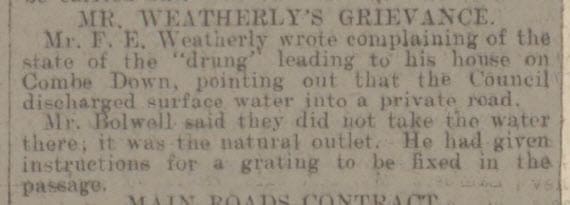
A trawl through the Bath Chronicle archives has literally hundreds of mentions of him – mostly court cases for his legal work.
There is also a small complaint he wrote about the discharge of water down the drung beside his house that earned him a grating to, presumably, drain the water.
He died at his home, Bathwick Lodge, Bath, after a short illness on 7 September 1929, at the age of 80.
At his funeral in Bath Abbey, the Londonderry Air, to which he had written the well-known words, was played as a voluntary.
He was buried at Smallcombe Cemetery. A plaque unveiled by Dame Clara Butt commemorates him at 10 Edward Street in Bath.
He is most famous for his music and Danny Boy.
Oh, Danny boy, the pipes, the pipes are calling From glen to glen, and down the mountain side. The summer's gone, and all the roses falling, It's you, it's you must go and I must bide. But come ye back when summer's in the meadow, Or when the valley's hushed and white with snow, It's I'll be here in sunshine or in shadow, — Oh Danny boy, Oh Danny Boy, I love you so! But if you come, when all the flowers are dying, And I am dead, as dead I well may be, Ye'll come and find the place where I am lying, And kneel and say an "Avé" there for me. And I shall hear, though soft you tread above me, And all my grave will warmer, sweeter be, For you will bend and tell me that you love me, and I will sleep in peace until you come to me!
The first recording of Danny Boy by Ernestine Schumann-Heink (1861 – 1936) in 1917.
By 1918 Charles Norris Williamson (1859 – 1920) and his wife Alice Muriel Livingston, née King, (1869 – 1933) were at Grosvenor Lodge and they changed the name to St Christopher.
Charles Norris Williamson was a writer, motoring journalist and founder of the Black and White – an illustrated weekly periodical that published fiction by Henry James, Bram Stoker, H. G. Wells, Jerome K. Jerome and many other well known writers of the day. However, he was perhaps best known for his collaboration with his wife in a number of novels and travelogues.
When he arrived in Bath he was already seriously ill.
By 1929 Maj George Herbert Greens Oswald (1873 – 1958) and his wife Evelyn Susan Oakey (1874 – 1956) were in residence.
He was a civil engineer but I have been able to establish no more about him.
By the 1930s Walter Francis Anthony Ermen MA FRPS (1875 – 1936) and his wife Florence Brook Shirt (1879 – 1962) and their family lived at St Christopher.
His son Anthony Cuthbert Guy Ermen (1904 – 1967) was still in residence in 1939 according to Kelly’s.
Vale View
Vale View seems originally to have been called Stamp Cottage after Jacob Stamp (1822 – 1898) and his wife Sarah Skeates (1819 – 1908).
They appear in the 1861 census under Stamps Cottage and in the 1871, 1881 and 1891 censuses under Vale View.
Other than that he was a stone mason and that they had eight children, four of who died as children: Frederick George Stamp (1850 – 1911), William James Stamp (1851 – 1934), Henry Stamp (1852 – 1852), Henry Jacob Stamp (1853 – 1931), Anne Stamp (1857 – 1925), Emily Sarah Stamp (1860 – 1863), Mary Ann Stamp (1862 – 1863) and Joseph Stamp (1862 – 1863) I have not been able to find out any more except there is a grave at Monkton Combe
In loving memory of my dear husband Jacob Stamp who died Feb. 17, 1898 Aged 76 years. Also of Sarah beloved wife of the above who died Jan. 15, 1908 Aged 88 years Also of Henry Stamp who died Nov. 5, 1852 Aged 10 weeks. Emily Stamp who died March 31, 1863, Aged 3 years & 5 months Mary Stamp who died March 31, 1863, Aged 11 months Joseph Stamp who died Nov. 26, 1863, Aged 1 year & 6 months beloved children of the above Also of my dear brother Benjamin S. . . . (Skeates)
By 1901 Anna Maria Tuckfield Pudsey (née Raymond) (1850 – 1928) with four of her children and was still living there in 1911 with two of them.
She was the widow of Rev Frederick William Pudsey (1839 – 1891) and the daughter of Commodore George Raymond RN (1793 – 1866) and Anna Maria Tuckfield (1811 – 1873). She was still there in the 1911 census and in Kelly’s Directory for 1919 and 1923.
Her brother was Edgar Harold Pudsey (1883 – 1971) who married Winifred Lillie Vaughan Jenkins (1884 – 1949) a daughter of William Vaughan Jenkins (1853 – 1897) and Lucinda Watts (1858 – 1911) of Combe Grove Manor.
By 1929 Mrs R E Haslam or Gertrude Mary Dorothy Haslam (maiden name unknown) (1884 – 1957) was living at Vale View, where she lived until she died.
I have been unable to establish more other than that she seems to have run kennels and came second in a Colmers photography competition.
West Brow
In 1871 William Henry Tucker (1814 – 1877) and his wife Emily Hannah Hendy (1815 – 1885) together with his fourth daughter Laura (1851 – 1920) live at West Brow.
He founded William Henry Tucker & Co, woollen cloth merchants.
The Diary of William Henry Tucker 1825 – 1850, edited by Helen Rogers, published by the Wiltshire Record Society tells of some of his life.
A review by by Richard Maidment says:
William Henry Tucker started in a clothier's counting-house in 1827, aged 13. He became a successful travelling salesman for J. T. Stancomb at Cradle Bridge Mill before setting up his own business. He tells of the smoke and dust in which Trowbridge was enveloped in his youth, “the stench” of the factory where he worked and the “the shaking occasioned by the machinery and the unwholesome heat”. There are mentions of industrial unrest and frequent references to funerals and illness – after a bad bout of typhus he meets the men who had been “preparing for the task of carrying me to my grave”. But his diary also shows his vigour and enjoyment of life. “What shall I do with all these girls?” he asks after the birth of his third daughter but he is a proud and interested parent. He is a keen cricketer and in 1832 he attends the Trowbridge Reform Festival with its “donkey racing, pig hunting, greasy pole climbing and other intellectual amusements”. He is a great traveller – often on foot, but even before the railway arrived at Trowbridge the transport facilities open to him are surprisingly developed; on a business trip in August 1847 he takes the afternoon boat to Bath and then on by rail to Birmingham via Bristol and Gloucester; over the next two days he returns through Worcester, Cheltenham, Gloucester, Stroud and Swindon before taking “a pleasant ride home” from Chippenham “in Little's van”. There are many outings to escape from the smoke of Trowbridge, walking for miles in the countryside, bathing in the river or canal, skating in winter, picnicking on the way to Longleat, “cowslipping” at Rood Ashton and boating at Orchardleigh. Despite leaving school at 13 he was a great reader and an often caustic, writer, with the outspokenness of the pre–Victorian age even when commenting on leading citizens of Trowbridge or the entertaining qualities of the many religious services he attended. One Sunday in September 1835, he and a companion walked to Holt church in the morning, “secreting our provisions in the hedge”, ate their lunch at the Bell at Broughton Gifford, “where I ordered two and a half pints of strong beer and twopence worth of bread with some quantum of cheese”, before continuing to Broughton church – “a most barbarous place and a most contemptible parson, unfit for anything but a scarecrow, and the music of the choir was certainly excelled in point of melody by the geese that cackled on the common”. They then walked home “through storms and sunshine” to hear Mr Eacott preach at the Bethel chapel in the evening! William Tucker was an informative and entertaining man and Helen Rogers provides maps, photographs, and an excellent introduction putting his life and diary in its historical context.
In 1881 West Brow as occupied by Maj Gen Joseph Fletcher Richardson CB (1823 – 1900) and his wife Mary Hannah Reily (1829 – 1908) with two of their children.
He had served in India in the 49th Regiment of Bengal Native Infantry and his death had been erroneously reported in 1862.
One of his sons was Lt Gen Sir George Lloyd Reilly Richardson, KCB CSI CIE (1847 – 1931).
West Brow was reported as unoccupied in the 1891 census, but Kelly’s for 1897 has the house occupied by Sir William Blunt 7th Baronet (1826 – 1902).
The Blunt Baronetcy was created on 17 June 1720 for John Blunt. He was a director of the South Sea Company.
His great-grandson, Sir Charles Richard Blunt, 4th Baronet (1775 – 1840), represented Lewes in the House of Commons from 1831 to 1840.
Then the line of succession gets complicated!
Sir Charles Richard Blunt’s line of the family failed on the death of his son, Sir Walter Blunt, 5th Baronet (1826–1847).
Thus was he succeeded by his first cousin, Sir Charles William Blunt, 6th Baronet (1810–1890).
He was the son of Richard Charles Blunt (1777 – 1846), second son of Sir Charles William Blunt, 3rd Baronet (1731–1802).
Sir Charles William Blunt died unmarried and was succeeded by his first cousin, Sir William Blunt, 7th Baronet (1826–1902), who occupied West Brow.
He was the son of William Blunt (1779 – 1860), third son of Sir Charles William Blunt, 3rd Baronet (1731–1802).
Sir William Blunt, 7th Baronet (1826–1902), despite being married twice, died childless and was succeeded by his younger brother, Sir John Harvey Blunt, 8th Baronet (1839–1922) who had fought in the Indian Rebellion of 1857.
By 1901 West Brow was occupied by James William Soane (1833 – 1912) and his wife Maria Johnson North (1837 – 1909) and their daughter Katherine Mabel Soane (1869 – 1925). He and his daughter were there in the 1911 census too, his wife having died at West Brow in 1909.
He described himself as a “Retired music dealer” but had started off as a piano tuner. He had worked with John Broadwood & Sons but at sometime had become employed by C Milsom & Son, then at 2 Argyle Street.
By 1865 he had decided to leave and Milsom’s placed adverts saying he had been discharged to which he placed adverts saying that he had not been discharged but left.
Once the dispute had passed he placed adverts for himself and, over time, grew his business.
In 1909 just a few months after his wife had died he wrote to the Bath Chronicle about how his wire saved his daughter and grand daughter from death on the missing SS Waratah.
The SS Waratah a luxury passenger and cargo ship, sailed on its maiden voyage from London to Australia on 5 November 1908 under the command of 69-year-old Captain Joshua Ilbery who had 30 years experience.
Blue Anchor Line’s newest edition to its fleet of 20 vessels was 495 feet long and 9,339 tons.
She had eight state rooms, 100 first class cabins, a saloon and a music lounge.
For her role bringing emigrants to Australia, the cargo holds could be converted into dormitories housing 700 steerage passengers.
When not carrying those steerage passengers, the Waratah could carry 15,000 tons of cargo and coal in her separate watertight compartments … similar to those on the Titanic.
She had lifeboats for 921.
On 1 July 1909 she set out from Melbourne on the return journey. The Waratah left Durban for Cape Town on 26 July carrying 211 passengers and crew, but disappeared somewhere off the East coast with all on board.
On 27 July she passed the steamer Clan McIntyre. That ship’s crew said that all seemed well and that the Waratah was making easy going of the rising seas and winds and quickly pulled ahead of their ship before disappearing over the horizon to the southwest.
Later that day, the weather deteriorated quickly with winds gusting to 50 knots combined against the tide and ocean swell to build waves up to 30 feet.
That same evening the Union-Castle liner Guelph, heading north to Durban from the Cape of Good Hope, passed a ship and exchanged signals by lamp, but because of the bad weather and poor visibility was able to identify only the last three letters of her name as “T-A-H.”
The same evening, a ship called the Harlow saw a large steamer coming up astern of her, working hard in the heavy seas and making a great deal of smoke, enough to make her captain wonder if the steamer was on fire.
When darkness fell, the crew of the Harlow could see the steamer’s running lights approaching, but still 10 – 12 miles behind them, when there were suddenly two bright flashes from the vicinity of the steamer and the lights vanished.
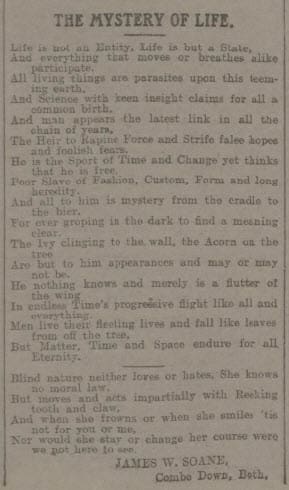
The mate of the Harlow thought the flashes were brush fires on the shore – a common phenomenon at that time of year. The captain agreed and did not even enter the events in the log – only when he learnt of the disappearance of the Waratah did he think the events significant. Reportedly the Harlow was 180 miles from Durban.
The Waratah was expected to reach Cape Town on 29 July 1909, but never reached its destination. Sometimes called the ‘South Atlantic Titanic’ no trace of the ship has been found.
Before he died James William Soane had a poem entitled “The Mystery of Life” published in the Bath Chronicle.
In 1919, according to Kelly’s, Maj Harry Edward Meade OBE (1884 – 1952) was living at West Brow, presumably with his wife Marion Emily Chadwick (1888 – 1976) and children.
He was related to the Hippisley family of Ston Easton Park via his step grand mother Charlotte Mary Hippisley (1836 – 1888), but other than that I have been able to establish nothing.
By 1920 Maj Arthur John St George French French (1853-1920) and his wife Pauline Anna Haddock (1866-1925) lived at the house.
By 1924 Eliza Margaret Jane Gollan (1850 – 1938) pseudonym ‘Rita’, known as Mrs W. Desmond Humphreys was living at West Brow.
‘Rita’ was born in Inverness, where her father was a landowner, having formerly been a businessman in India.
Her parents’ marriage was violent and unhappy.
Her father took the family to Sydney, Australia when she was young but did not ‘make his fortune’ and, around 1874, with her mother a chronic invalid the family returned to England.
Her education was second hand from her brother’s tutor.
She began writing after a broken engagement, taking her pen name Rita in homage to her idol, Ouida, real name Maria Louise Ramé, (1839 – 1908) whose novels she had been forbidden to read in childhood.
Her first marriage was to the composer Karl Edmund Otto von Booth (1842 – 1923). He owned a well known Stradivarius – the Booth Stradivarius. He was regarded as an unsuitable match by her parents and the marriage went badly. She describes aspects of it in her novel Sâba Macdonald (1906).
Secondly she married William Ernest Humphreys (1858 – 1938), an Irishman.
They lived for many years at Youghal and she became knowledgeable about Ireland.
‘Rita’ wrote numerous romantic novels, aimed at female library subscribers.
Although her principal model was Ouida, reviewers noted that she lacked Ouida’s wickedness. ‘Rita’ was particularly fond of journal and diary novels and her stories feature ‘willowy forms, flashing eyes, long, long embraces and clinging kisses’.

Her best, probably semi autobiographical work, is Sheba (1889), the story of a wild Australian girl whose childhood is similar to her own.
Other novels include: Vivienne Borrow (1877); Fragoletta (1881); My Lady Coquette (1881); Two Bad Blue Eyes (1884); Corinna (1888), A Husband Of No Importance (1894), The Rake (1894) and Souls (1903). In Recollections Of A Literary Life (1936) Rita says she was ‘robbed unmercifully’ by publishers during her long career.
She came to Bath in 1924. She was a devotee of theosophy and knew Helena Blavatsky (1831 – 1891).
She was also a great admirer of Mary Augusta Ward CBE (née Arnold) (1851 – 1920), grand daughter of Thomas Arnold (1795 – 1842) who was, perhaps, best known as headmaster of Rugby School from 1828 to 1841.
By 1939 West Brow was occupied by Harry Robinson (1879 – 1948) and his wife Beatrice May Parker (1882 – 1952). He had been manager of National Provincial Bank in Combe Down between about 1906 and 1936.[5]
His son Keith Harry Brian Robinson (1908 – 1984) had a careless driving charge dismissed in 1947 after and accident with a bus on Bradford Road.
He was still living at West Brow in 1948 after his father’s death presumably with his wife Veda Mary Tucker (1906 – 1963). They later emigrated to New Zealand.

